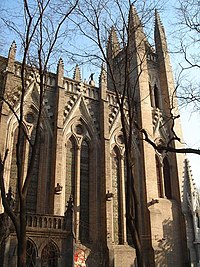Xishiku Cathedral
| Church of the Saviour, Beijing | |||||||||

The west facade
|
|||||||||
| Traditional Chinese | 救世主堂 | ||||||||
|---|---|---|---|---|---|---|---|---|---|
| Simplified Chinese | 救世主堂 | ||||||||
|
|||||||||
| Alternative Chinese name | |||||||||
| Chinese | 北堂 | ||||||||
| Literal meaning | The North Cathedral | ||||||||
|
|||||||||
| Transcriptions | |
|---|---|
| Standard Mandarin | |
| Hanyu Pinyin | Xīshénkù Tiānzhǔ Táng |
| Wade–Giles | Hsīshénk'ù T'iēnchǔ T'áng |
| Transcriptions | |
|---|---|
| Standard Mandarin | |
| Hanyu Pinyin | Běitáng |
| Wade–Giles | Pěitáng |
The Church of the Saviour (Chinese: 救世主堂), colloquially referred to as Xishiku Church (Chinese: 西什库天主堂) or Beitang (Chinese: 北堂; literally: "the North Church") is a historic Catholic church in the Xicheng District, Beijing, China. Of all the cathedrals and churches located in Beijing, the Xishiku church is one of the most ornate and magnificent.
The church was originally established by the Jesuits in 1703 near Zhongnanhai (opposite the former Beijing Library), on land bestowed by the Kangxi Emperor of the Qing dynasty to the Jesuits in 1694, following his recovery from illness thanks to medical expertise of Fathers Jean-François Gerbillon and Joachim Bouvet. The emperor also hand-wrote the calligraphy plaque and couplets for the building. It was named "Saviour Church" and officially opened on 9 February 1703.
In 1887 the church was moved and rebuilt at its current location, at the request of the Guangxu Emperor, who needed the original space near the Forbidden City to create the Zhongnanhai Park. The cathedral's present cast iron Gothic architectural style and elaborate grey marble facade was built in 1890, under the direction of Lazarist missionary Bishop Pierre-Marie-Alphonse Favier (1837-1905), who designed it. The church stands in a spacious grounds surrounded by pine and oak tree and two Chinese pavilions.
The church is also where the Beijing Bishop Office is located and it is affiliated with the Patriotic Catholic Church of China.
...
Wikipedia
